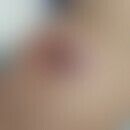DefinitionThis section has been translated automatically.
Skin disease which is exclusively or partly due to workplace influences (occupational disease). The assessment of an occupational dermatosis always has to be made individually under consideration of the workplace conditions. An occupational dermatosis has to be distinguished from an occupational skin disease (e.g. occupational disease according to BK 5101) or an accident at work (§ 8 SGB VII).
ClassificationThis section has been translated automatically.
The predominant number of occupational dermatoses (> 95%) is formed by the eczema group. The following classification is accepted:
- Common diseases (see below occupational skin disease):
- Atopic hand eczema, congenital, work-related exacerbation
- Cumulative toxic eczema
- Allergic contact eczema
- Psoriasis palmaris et plantaris, congenital, work-related aggravation
- Physical urticaria.
- Rarer diseases (see Tab. 1 BK list of possible dermatological diseases):
- Professional acne
- Dermatomycoses
- Bacterial diseases (e.g. mycobacterioses)
- Virus dermatoses ( cowpox, milking knots, ornithoses)
- Dermatozoonoses
- Dermatoses caused by ultraviolet, thermal or ionising radiation
- Dermatoses due to inclusions of foreign materials ( beryllium, aniline, asbestos)
- Dermatoses due to chronic intoxications ( arsenic, uranium).
You might also be interested in
General therapyThis section has been translated automatically.
- According to § 3 BeKV (Ordinance on Occupational Diseases), a patient with an occupational dermatosis, if its aggravation, recurrence or the concrete danger of the development of an occupational disease of the skin is threatening, the development of an occupational disease must be treated "with all suitable means" at the expense of the statutory accident insurance institution (usually professional association) preventively ( prevention).
- The treatment includes therapeutic as well as skin protection and skin care measures. At the expense of the accident insurance carrier, e.g. skin-friendly cleansing preparations (syndets), bath oils, skin-caring external preparations with and without active substances as well as skin protection preparations may be prescribed. Measures at the expense of the accident insurance carrier may only be taken after its approval. This is requested by the treating dermatologist with the dermatologist's report.
- The prescriptions are only made on a prescription form from the health insurance company, stating the name of the accident insurance company and the file number. The prescription fees are waived for the patient ("free of charge" check the box!). As the prescribed preparations are not paid for by the statutory health insurance companies, they are not charged to the drug budget.
- Preventive skin protection measures at the workplace include:
- Technical and organisational measures at the workplace, e.g. encapsulation of a lathe, replacement of cooling lubricants, chromium-free tanned work shoes, protective gloves and general skin protection measures (cost absorption: employer).
- Although leather tanning with chromate (IV-valent chromium) is prohibited in Germany, foot eczema with proven chromate sensitisation is still frequently found. Tanning with chrome III-containing chrome alum is permitted. It is disputed whether an oxidation of chromium III ions into chromium IV ions is possible. The allergenicity of chromium III is low, cross-allergenicity to chromate IV is rarely described. The discrepancy can be explained by the fact that, due to the incomprehensible interrelationships in the shoe industry, chromate-tanned shoes are still occasionally coming onto the market. The review of the regulation is only carried out on a random basis. Chromium-free can only be assumed with 100% certainty for those manufacturers who expressly use leather that is free of chromate, i.e. leather that has been tanned using vegetable dyes. In some occupational groups, such as bricklayers or miners, chromate sensitization can be triggered by cement penetrating into the work shoes.
- Personal protective measures: Individual skin protection preparations, in exceptional cases protective gloves, supporting measures for gentle cleaning and regeneration of the skin, hardening measures (UVA/PUVA). Cost absorption: Statutory accident insurance carrier (according to § 3).
- Medical treatment, outpatient inpatient therapy, cures. Cost absorption: Statutory accident insurance institution (according to § 3). Only when all means of prevention have been exhausted should a change of job be made.
As a rule, occupational dermatoses are hand eczema. - Cumulative sub-toxic hand eczema, toxic hand eczema: Most frequent form of occupational hand eczema, especially in housewives, hairdressing, machining, cleaning and care staff, butchers, bricklayers, bakers. Only if it is not possible to carry out preventive measures (e.g. wearing protective gloves as a baker) is the abandonment of the workplace unavoidable.
- Toxic hand eczema: Toxic contact dermatitis heals rapidly after avoiding the noxious agent. If the noxious agent is handled properly, no further skin problems will normally occur. The patient can remain at the workplace.
- Hand eczema, atopic: The onset of atopic hand eczema is a multifactorial process which does not depend exclusively on the action of the external noxious agent. In humid professions, however, there is often an exogenous triggering of hand eczema by irritant noxae. In case of substantial partial cause or trend-setting aggravation by the occupational activity (congruence of work), the atopical hand eczema also becomes an occupational dermatosis or an occupational disease of the skin.
- Allergic contact eczema: usually type IV sensitization (see below allergy). Usually heals quickly after allergen elimination. If contact cannot be avoided by specific protective measures (e.g. gloves), a change of job is often unavoidable.
The special skin protection measures depend on the quality of the noxious agent causing the contact. In the case of contact allergies, the focus is on avoiding (replacing) the allergen. If this is not possible, it may be possible to remain at the workplace with suitable protective gloves (see Table 2). For non-specific noxious agents (cumulative toxicity), protective gloves are the first priority. Skin protection preparations are of secondary importance. Accompanying cleaning and moisturizing of the skin. - Gloves: Best protection against external noxious agents. However, rubber gloves contain potent allergens (vulcanisation accelerators, antioxidants, etc.) and therefore also represent a potential danger. Vinyl gloves can be used if rubber ingredients such as latex, mercaptobenzothiazole, thiurams, carbamates etc. are incompatible. Vinyl gloves are generally preferable to rubber gloves (no additives!).
- Skin protection products
:Basic principle: The noxious agent should not be soluble in the product to make penetration into the skin more difficult. Skin protection against water soluble substances is therefore achieved by W/O bases, skin protection against water insoluble substances by O/W bases.
Caution!
The wrong foundation can improve the penetration of the noxious agent into the skin and increase skin damage! A skin protection plan should be drawn up for every activity that is harmful to the skin. This includes skin cleansing, skin protection and skin care adapted to the noxious agent, see also Table 3, 4.Industrially manufactured preparations always contain preservatives and usually also fragrances which may have a sensitising effect. The preservatives used vary from preparation to preparation. If the sensitization is known, the ingredients have to be clarified in advance.TablesThis section has been translated automatically.
Profession |
Noxae |
Hairdressers |
P-phenylenediamine (colouring agent), glycerol monothioglycolate (perm), ammonium persulphate (bleaching agent), gum ingredients, perfumes |
Farmers |
Gum ingredients, pesticides, medicines |
Bricklayer |
Chromate, rubber ingredients |
Nursing professions |
gum ingredients, disinfectants, pharmaceuticals, cosmetic ingredients |
Florists |
Flowers (primroses, composite plants), pesticides |
Miners |
Chromate, rubber ingredients |
Machining professions |
Preservatives, oil additives |
Cleaning professions |
Disinfectants, rubber ingredients |
Food Professions |
disinfectants, food, preservatives |
Locksmith |
Oil additives (preservatives etc.), rubber ingredients, cooling lubricants |
Dental Technician |
Acrylates, metals |
Body mechanic |
Epoxy resins, oil additives, cooling lubricants |
Photographer |
Developers (P-phenylenediamine derivatives), rubber ingredients |
Joiner |
Wood, varnishes, resins, adhesives |
Tilers |
Chromate, epoxy resins, acrylates |
Printer |
cooling lubricants, rubber ingredients |
Protective gloves in different professions
Profession |
Activity |
Glove |
Remarks |
Hairdressing trade |
Hair Washing |
Wash glove (e.g. Ansell Edmont, Eislingen Wash glove art. no. 79-200) |
Wearing and provision of suitable gloves is mandatory (TRGS 530 Hairdressing Trade)! |
Dyeing, bleaching, for perms |
Vinyl-HS (e.g. Marygold Industrial long "Suretech" Company London, Mönchengladbach), Nitrillatex-HS (e.g. from Ansell Edmond "Touch'N Tuff") |
"Industrial long" has extended gauntlet |
|
Mechanical engineering industry |
in particular for metal cutting professions |
Cotton-HS dipped in plastic or rubber |
Wearing HS often not allowed for safety reasons |
Construction industry |
Rubber dipped cotton-HS |
|
|
Food industry |
PVC (vinyl) HS or rubber dipped cotton HS |
|
|
Butcher |
Sale |
Vinyl-HS (e.g. Industrial long "Suretech" from London) |
"Industrial long" has extended gauntlet |
Slaughter and boning |
Rubber dipped cotton HS under chain HS |
|
|
Cleaning professions |
Vinyl-HS (e.g. household HS Fa. Ansell Edmont Art. No. 79-100), rubber dipped cotton-HS |
|
|
Public Health |
Non-sterile activity |
Vinyl-HS |
Powder Free |
Sterile activity |
Non-powdered latex HS (e.g. Ansell, Manex powder-free) |
For latex allergy: sterile neoprene HS (e.g. Dermaprene from Ansell, Neoderme from Manex) |
|
model making technician, dental technician |
Treatment and processing of acrylates |
4-h-gloves (e.g. from GIA GmbH Bochum) protect for 4 hours also as finger cots or polyethylene HS |
With acrylate sensitization, a change of activity is often unavoidable |
Skin protection with different noxious agents
|
Examples of harmful noxious agents |
Sample preparations from selected suppliers |
||
Stockhausen Krefeld |
Reinol Lever-Sutter/Mannheim |
Basotherm (Biberach/Riss) |
||
Skin protection against water soluble substances |
Washing water, water-miscible cooling lubricant, concrete, acids, alkalis, salts, pickling agents, lime, food, cleaning agents |
Taktosan-HSS Taktosan emulsion Stoko emulsion (food sector), Taktodor (moisture retention) |
Reinol-B-HSC, Reinol-Aquagard |
Saniwip-HSC, |
Skin protection against water insoluble substances |
Oils, greases, drilling oils, cutting oils, paints, varnishes, lacquer thinners, adhesives, petrol, petroleum, organic solvents, synthetic resins, metal dust |
Travabon-HSS Travabon L (with silicon dioxide) |
Reinol F-HSC, Reinol-Drygard |
Sansibal-HSC |
Imprint free skin protection products |
|
|
|
Sineprint (imprint free) |
Skin cleansing and skin care
Skin cleansing |
Light soiling |
Neopol Cream, Frapantol Soap |
Reinol Soap Lotion |
Saniklin Wash Liquid, Stephalen Wash Gel |
Medium pollution |
Solopol Paste |
Reinol-K HWP, Reinolen (food) |
Saniscrub scrub cream |
|
Coarse soiling |
Cresto Paste |
Reinol-HWP |
Saniscrub scrub cream |
|
|
Special soiling (varnishes, oil paints, adhesives, etc.) |
Cupran liquid, Slig liquid, Slig special, Reduran, Reduran special |
Lacosan (lacquers), pure oil liquid, Sumanol powder soap |
Contra Color (paints, varnishes) |
|
| ||||
Skin Care |
|
Stokolan Cream, Stokolan Lotion |
Reinol-Dermasoft |
Physioderm cream, Stefatop lotion |
List with possible dermatological diseases
Occupational disease number |
Diseases |
1 |
Diseases caused by chemical agents |
11 |
Metals and metalloids |
1101 |
diseases caused by lead or its compounds |
1102 |
Diseases caused by mercury or its compounds |
1103 |
diseases caused by chromium or its compounds |
1104 |
diseases caused by cadmium or its compounds |
1105 |
diseases caused by manganese or its compounds |
1106 |
diseases caused by thallium or its compounds |
1107 |
diseases caused by vanadium or its compounds |
1108 |
diseases caused by arsenic or its compounds |
1109 |
diseases caused by phosphorus or its inorganic compounds |
1110 |
diseases caused by beryllium or its compounds |
12 |
Asphyxiant gases |
1201 |
Diseases caused by carbon monoxide |
1202 |
Diseases caused by hydrogen sulphide |
13 |
Solvents, pesticides and other chemical substances |
1302 |
Diseases caused by hydrogen halides |
1303 |
Diseases caused by benzene, its homologues or by styrene |
1304 |
diseases caused by nitro or amino compounds of benzene or its homologues or their derivatives |
1305 |
Diseases caused by carbon disulphide |
1306 |
Diseases caused by methyl alcohol (methanol) |
1307 |
Diseases caused by organic phosphorus compounds |
1308 |
diseases caused by fluorine or its compounds |
1309 |
Diseases caused by nitric acid esters |
1310 |
Diseases caused by halogenated alkyl, aryl or alkylaryl oxides |
1315 |
Diseases caused by isocyanates |
For numbers 1101 to 1110, 1201 and 1202, 1303 to 1309 and 1315: Skin diseases are excluded. These are considered diseases within the meaning of this Annex only in so far as they are manifestations of a general disease caused by the absorption of the harmful substances into the body, or in so far as they must be compensated in accordance with item 5101. | |
2402 |
Diseases caused by ionising radiation |
3 |
diseases caused by infectious agents or parasites and tropical diseases |
3101 |
infectious diseases, if the insured person worked in the health service, in welfare work or in a laboratory or was particularly exposed to the risk of infection to a similar extent through another activity |
3102 |
Diseases transmissible from animals to humans |
3104 |
Tropical diseases, typhus |
5102 |
Skin cancer or skin changes that tend to form cancer due to soot, paraffin wax, tar, pitch, anthracene or similar substances |
Note(s)This section has been translated automatically.
LiteratureThis section has been translated automatically.
- John SM et al (2007) Certificate: "Occupational Dermatology (ABD)". New curriculum 2006 of the CME-seminars of the Task Force of Occupational and Environmental Dermatology. German Dermatol Ges 5: 135-144
- Schwanitz HJ (2003) Preventive measures. In: Schwanitz HJ, Wehrmann W, Brandenburg S, John SM (Hrsg) Expert Opinion Dermatology Steinkopf Verlag, Darmstadt, pp. 17-31
Outgoing links (23)
Accident at work; Allergy (overview); Arsenic intoxication; Atopic hand dermatitis; Beryllium granuloma; Contact dermatitis allergic; Contact dermatitis toxic; Cowpox; Dermatomycoses; Dermatozoonoses; ... Show allDisclaimer
Please ask your physician for a reliable diagnosis. This website is only meant as a reference.




